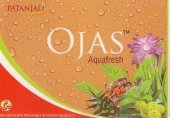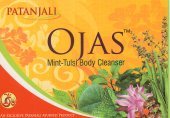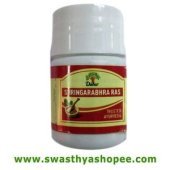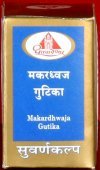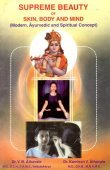Oja, Ojā: 21 definitions
Introduction:
Oja means something in Buddhism, Pali, Hinduism, Sanskrit, the history of ancient India, Marathi, Hindi, biology. If you want to know the exact meaning, history, etymology or English translation of this term then check out the descriptions on this page. Add your comment or reference to a book if you want to contribute to this summary article.
In Hinduism
Purana and Itihasa (epic history)
Source: Cologne Digital Sanskrit Dictionaries: The Purana Index1a) Oja (ओज).—A son of Kṛṣṇa and Mādrī.*
- * Bhāgavata-purāṇa X. 61. 15.
1b) Created by Brahmā from his mouth.*
- * Viṣṇu-purāṇa I. 5. 48.
1c) The yakṣa presiding over the month of mādhava.*
- * Bhāgavata-purāṇa XII. 11. 34.

The Purana (पुराण, purāṇas) refers to Sanskrit literature preserving ancient India’s vast cultural history, including historical legends, religious ceremonies, various arts and sciences. The eighteen mahapuranas total over 400,000 shlokas (metrical couplets) and date to at least several centuries BCE.
In Buddhism
Theravada (major branch of Buddhism)
Source: Pali Kanon: Manual of Buddhist Terms and Doctrines'nutriment' (synonym of āhāra, q.v.), is one of those 8 minimal constituent parts, or qualities, of all corporeality, to wit: the solid, liquid, heat, motion; colour, odour, taste and nutriment.
This is the 'octad with nutriment as the eighth (factor)' (ojatthamaka-kalāpa), also called the 'pure eightfold unit' (suddhatthaka-kalāpa), being the most primitive material combination.
For further details, s. rūpa-kalāpa.
Source: Pali Kanon: Introducing Buddhist Abhidhammalit: 'nutriment'; Property of matter (rupa).
Theravāda is a major branch of Buddhism having the the Pali canon (tipitaka) as their canonical literature, which includes the vinaya-pitaka (monastic rules), the sutta-pitaka (Buddhist sermons) and the abhidhamma-pitaka (philosophy and psychology).
India history and geography
Source: Cologne Digital Sanskrit Dictionaries: Indian Epigraphical GlossaryOja.—(SII 11-1), same as Ojhā; designation derived from Sanskrit Upādhyāya; cf. Bengali Ojhā, Maithilī Jhā. Note: oja is defined in the “Indian epigraphical glossary” as it can be found on ancient inscriptions commonly written in Sanskrit, Prakrit or Dravidian languages.

The history of India traces the identification of countries, villages, towns and other regions of India, as well as mythology, zoology, royal dynasties, rulers, tribes, local festivities and traditions and regional languages. Ancient India enjoyed religious freedom and encourages the path of Dharma, a concept common to Buddhism, Hinduism, and Jainism.
Biology (plants and animals)
Source: Google Books: CRC World Dictionary (Regional names)Oja in Nigeria is the name of a plant defined with Afzelia africana in various botanical sources. This page contains potential references in Ayurveda, modern medicine, and other folk traditions or local practices It has the synonym Pahudia africana (Sm. ex Pers.) Prain (among others).
Example references for further research on medicinal uses or toxicity (see latin names for full list):
· Flora van Nederlandsch Indië (1855)
· The Languages of West Africa. (1911)
· Genera Nova Madagascariensia (1806)
· Transactions of the Linnean Society of London (1798)
· Revisio Generum Plantarum (1891)
· Journal of Tree Sciences (1985)
If you are looking for specific details regarding Oja, for example chemical composition, extract dosage, health benefits, side effects, diet and recipes, pregnancy safety, have a look at these references.

This sections includes definitions from the five kingdoms of living things: Animals, Plants, Fungi, Protists and Monera. It will include both the official binomial nomenclature (scientific names usually in Latin) as well as regional spellings and variants.
Languages of India and abroad
Pali-English dictionary
Source: BuddhaSasana: Concise Pali-English Dictionaryoja : (m.; nt.) nutritive essence; juice. || ojā (f.), nutritive essence; juice.
Source: Sutta: The Pali Text Society's Pali-English DictionaryOjā, (f.) (Vedic ojas nt. , also BSk. oja nt. Divy 105; fr. *aug to increase, as in Lat. auges, augustus & auxilium, Goth. aukan (augment), Ags. ēacian; cp. also Gr. a)έcw, Sk. ukṣati & vakṣana increase) strength, but only in meaning of strength-giving, nutritive essence (appld. to food) M. I, 245; S. II, 87; V, 162 (dhamm’); A. III, 396; J. I, 68; Dhs. 646, 740, 875; Miln. 156; DhA. II, 154 (paṭhav°). See also def. at Vism. 450 (referring to kabaliṅkār’āhāra. The compn. form is oja, e.g. ojadāna J. V, 243; ojaṭṭhamaka (rūpa) Vism. 341. (Page 165)

Pali is the language of the Tipiṭaka, which is the sacred canon of Theravāda Buddhism and contains much of the Buddha’s speech. Closeley related to Sanskrit, both languages are used interchangeably between religions.
Marathi-English dictionary
Source: DDSA: The Molesworth Marathi and English Dictionaryōja (ओज).—f (ūrjā S) Careful treatment or keeping; heed or attention unto in order to preservation in good condition or state. v rākha. 2 Careful performance or execution (of a business or work). 3 Management, handiness, expertness, dexterity. 4 Neat, orderly, or good condition. Pr. gharācī ōja aṅgaṇa sāṅgatēṃ.
--- OR ---
ōja (ओज).—n S Life, vitality, the vital faculty or principle. 2 Metallic lustre. 3 Virility. 4 Lustre.
Source: DDSA: The Aryabhusan school dictionary, Marathi-Englishōja (ओज).—f Careful treatment or keeping. v rākha. Careful performance or execu- tion, management. Neat, orderly or good condition. Ex. gharācī ōja aṅgaṇa sāṅgatēṃ. n Life, vitality. Lustre.
Marathi is an Indo-European language having over 70 million native speakers people in (predominantly) Maharashtra India. Marathi, like many other Indo-Aryan languages, evolved from early forms of Prakrit, which itself is a subset of Sanskrit, one of the most ancient languages of the world.
Sanskrit dictionary
Source: DDSA: The practical Sanskrit-English dictionaryOja (ओज).—a. Odd, uneven.
-jam = ओजस् (ojas) q. v.
Source: Cologne Digital Sanskrit Dictionaries: Edgerton Buddhist Hybrid Sanskrit DictionaryOjā (ओजा).—(= Pali id.; derived by Childers and Senart from Sanskrit ūrj, by [Pali Text Society’s Pali-English Dictionary] from ojas, which seems more plausible), food: Mahāvastu i.210.19 = ii.14.20 (prose) (lābhinī bhavati divyānāṃ gandhānāṃ…mālyānāṃ…vilepanānāṃ) di- vyānāṃ ojānām; ii.131.3 (and 6) (prose) (vayaṃ te roma- kūpa- [mss. °pe] vivarāntareṣu) divyām ojām adhyohari- ṣyāmaḥ; see s.v. adhyoharati (used in Pali, like its noun ajjhohāra, of food). It seems clear that in [Buddhist Hybrid Sanskrit], at least, ojā means simply food, not essence or the like.
Source: Cologne Digital Sanskrit Dictionaries: Shabda-Sagara Sanskrit-English DictionaryOja (ओज).—(ta) r. 1st. cl. (ojati) 1. To live, to have the vital faculties and organs. 2. To be strong or able.
--- OR ---
Oja (ओज).—m.
(-jaḥ) See the following.
Source: Cologne Digital Sanskrit Dictionaries: Cappeller Sanskrit-English DictionaryOja (ओज).—[adjective] odd (the first, third, etc.).
Source: Cologne Digital Sanskrit Dictionaries: Monier-Williams Sanskrit-English Dictionary1) Oja (ओज):—mfn. odd (as the first, third, fifth, etc. in a series), [Ṛgveda-prātiśākhya; Sūryasiddhānta; Varāha-mihira’s Bṛhat-saṃhitā]
2) m. Name of a son of Kṛṣṇa, [Bhāgavata-purāṇa]
3) = ojas, [cf. Lexicographers, esp. such as amarasiṃha, halāyudha, hemacandra, etc.]
Source: Cologne Digital Sanskrit Dictionaries: Yates Sanskrit-English DictionaryOja (ओज):—(jaḥ) 1. m. Light.
Source: DDSA: Paia-sadda-mahannavo; a comprehensive Prakrit Hindi dictionary (S)Oja (ओज) in the Sanskrit language is related to the Prakrit words: Oya, Viala.
[Sanskrit to German]
Sanskrit, also spelled संस्कृतम् (saṃskṛtam), is an ancient language of India commonly seen as the grandmother of the Indo-European language family (even English!). Closely allied with Prakrit and Pali, Sanskrit is more exhaustive in both grammar and terms and has the most extensive collection of literature in the world, greatly surpassing its sister-languages Greek and Latin.
Hindi dictionary
Source: DDSA: A practical Hindi-English dictionaryOja (ओज) [Also spelled oj]:—(nm) vigour and virility; lustre, splendour; ~[svī] vigorous and virile, brilliant; hence ~[svitā] (nf.).
...
Kannada-English dictionary
Source: Alar: Kannada-English corpusŌja (ಓಜ):—
1) [noun] a man who teaches, esp. whose occupation is to instruct; a teacher; a professional instructor.
2) [noun] (masc.) a man who models, carves or otherwise fashions figures or forms of clay, stone, metal, wood, etc.; an artist who creates three-dimensional representations; a sculptor; a carpenter; a smith.
--- OR ---
Ōja (ಓಜ):—
1) [noun] brightness; brilliance; lustre; radiance.
2) [noun] the power of procreation; male sexual potency; virility.
3) [noun] (rhet.) a particular literary style that abounds in compounds.
4) [noun] the vital force, power or principle as present in all living things; the life principle or force; vitality.
5) [noun] bodily strength; vigour; energy; ability.
6) [noun] water.
7) [noun] skill in the use of weapons.
8) [noun] speed; the impetus of a moving object; momentum.
--- OR ---
Ōja (ಓಜ):—
1) [adjective] (said of numbers) having a remainder of one when divided by two; not even; odd.
2) [adjective] occurring alternatively in first, third, fifth etc. places; odd.
Kannada is a Dravidian language (as opposed to the Indo-European language family) mainly spoken in the southwestern region of India.
Nepali dictionary
Source: unoes: Nepali-English DictionaryOja (ओज):—n. 1. light; 2. splendor; luster; 3. brilliance; fervor; 4. bodily strength; vigor; energy;
Nepali is the primary language of the Nepalese people counting almost 20 million native speakers. The country of Nepal is situated in the Himalaya mountain range to the north of India.
See also (Relevant definitions)
Starts with (+18): Ahara Rupa, Ojadipa, Ojagara, Ojagodagi, Ojagrihastha, Ojaguna, Ojahati, Ojahpratyaharini, Ojakshaya, Ojalu, Ojanem, Ojapati, Ojarashi, Ojarekhe, Ojas, Ojasi, Ojasina, Ojaska, Ojaskara, Ojassu.
Query error!
Full-text (+129): Ojas, Ojasvin, Amitaujas, Abhibhutyojas, Mahjas, Vidojas, Kaushikyoja, Krishtyojas, Udojas, Dhrishnvojas, Bhuryojas, Bahvojas, Nyojas, Asamatyojas, Tadojas, Tuvyojas, Ojastara, Anojas, Svojas, Praksharanauja.
Relevant text
Search found 103 books and stories containing Oja, Ojā, Ōja; (plurals include: Ojas, Ojās, Ōjas). You can also click to the full overview containing English textual excerpts. Below are direct links for the most relevant articles:
Rig Veda (translation and commentary) (by H. H. Wilson)
Yavanajataka by Sphujidhvaja [Sanskrit/English] (by Michael D Neely)
Verse 1.30 < [Chapter 1 - The Innate Nature of the Zodiac Signs and Planets]
Verse 10.11 < [Chapter 10 - The Application of the Yogas of the Moon]
Verse 10.3 < [Chapter 10 - The Application of the Yogas of the Moon]
The backdrop of the Srikanthacarita and the Mankhakosa (by Dhrubajit Sarma)
Part 3b - Guṇa (2): Ojaḥ (Ojas) < [Chapter III - Literary Assessment Of The Śrīkaṇṭhacarita]
Part 3 - Guṇa or the quality < [Chapter III - Literary Assessment Of The Śrīkaṇṭhacarita]
Part 1 - Rīti or the style < [Chapter III - Literary Assessment Of The Śrīkaṇṭhacarita]
Malatimadhava (study) (by Jintu Moni Dutta)
Part 4.3b - Ojas Guṇa (Floridity) < [Chapter 2 - Literary Study of the Mālatīmādhava]
Part 4.1-2 - Definition of Guṇa (quality—principal element) < [Chapter 2 - Literary Study of the Mālatīmādhava]
Part 3.3b - Gauḍī Rīti < [Chapter 2 - Literary Study of the Mālatīmādhava]
Sahitya-kaumudi by Baladeva Vidyabhushana (by Gaurapada Dāsa)
Text 8.9 < [Chapter 8 - Literary Qualities]
Text 8.12 < [Chapter 8 - Literary Qualities]
Text 8.8 < [Chapter 8 - Literary Qualities]
Mudrarakshasa (literary study) (by Antara Chakravarty)
2. The theory of rīti < [Chapter 5 - Adoption of Style and Language in Mudrārākṣasa]
1. Guṇa: It’s classification and components < [Chapter 5 - Adoption of Style and Language in Mudrārākṣasa]
3. Guṇa and Rīti applied by Viśākhadatta < [Chapter 5 - Adoption of Style and Language in Mudrārākṣasa]
Related products
